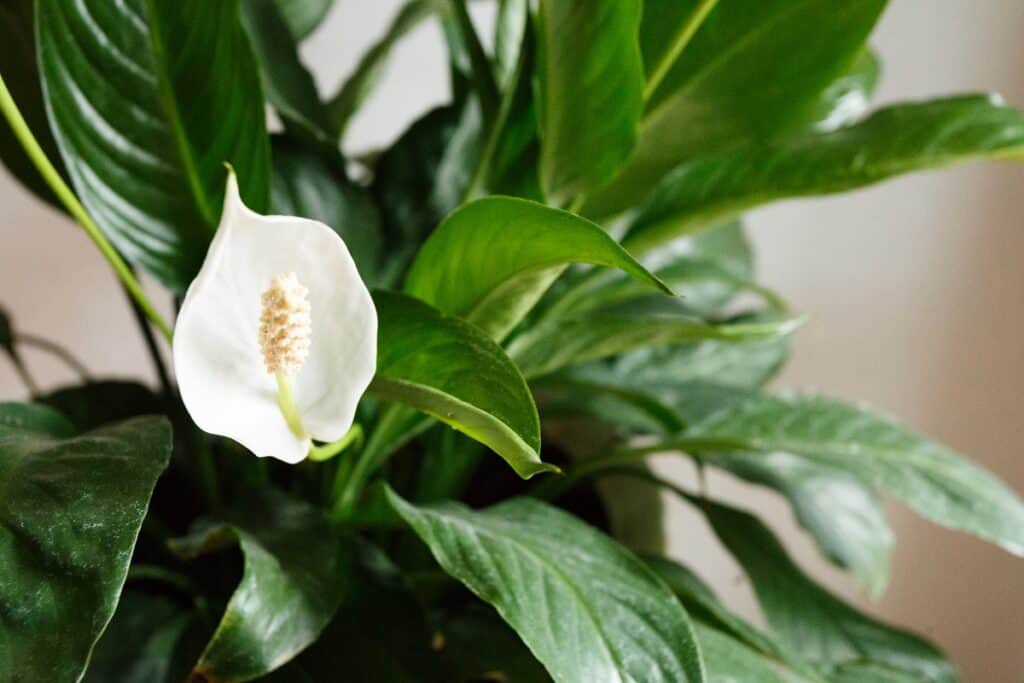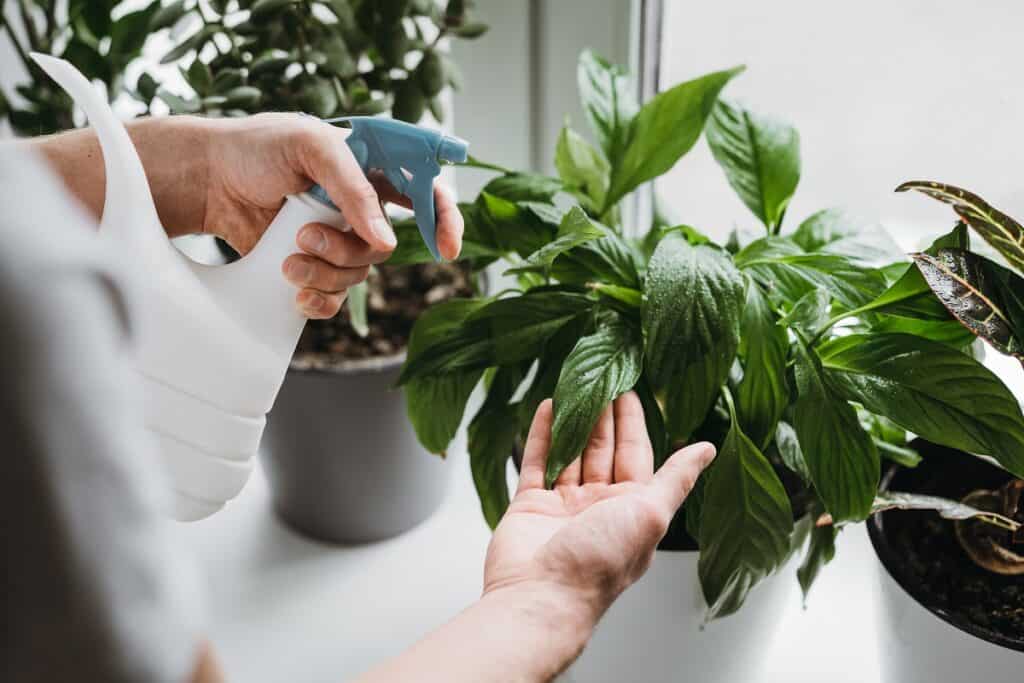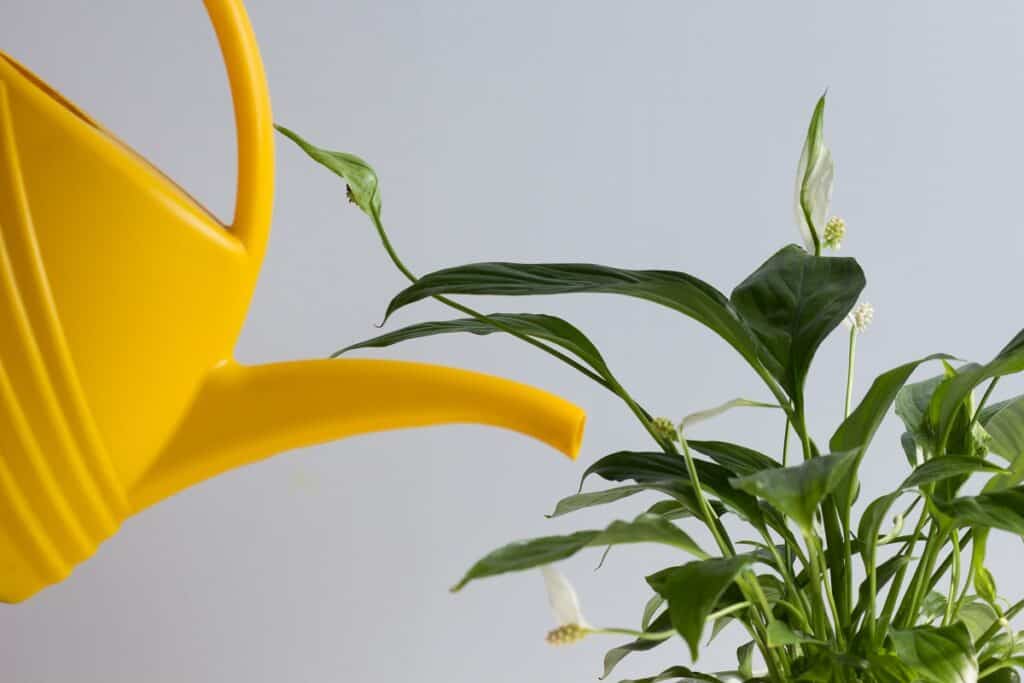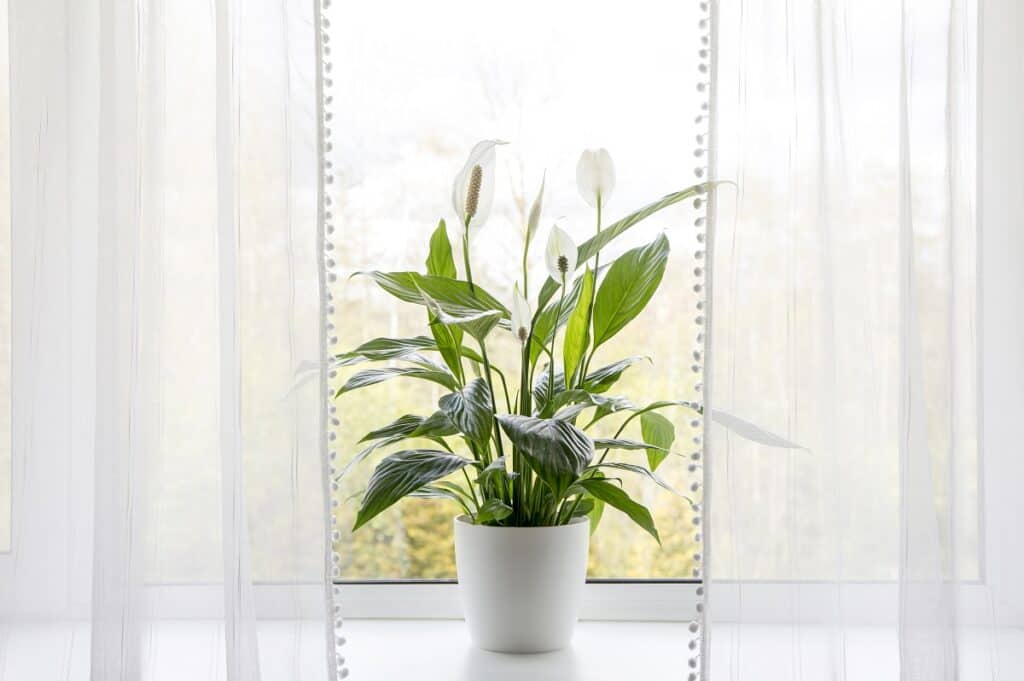Do you have a peace lily in your home or office? Are you struggling to keep the plant healthy? If so, you may be curious to know the answer to “Do peace lilies like humidity?”.
Humidity is a measure of the water content in the air. While many plants, such as orchids, require higher levels of humidity to thrive, peace lilies are unique in their ability to tolerate a wide range of humidity levels. In some cases, too much humidity can be more detrimental to a peace lily’s health than too little.

Contents
- 1 Do Peace Lilies Like Humidity?
- 2 Signs Of Too Much Humidity For Peace Lilies
- 3 How To Increase Humidity For Peace Lilies
- 4 Common Mistakes To Avoid With Peace Lilies And Humidity
- 5 What Conditions Do Peace Lilies Prefer?
- 6 Frequently Asked Questions
- 6.1 Do peace lilies need humidifiers?
- 6.2 Do peace lilies like to be misted with water?
- 6.3 Should I mist my peace lily everyday?
- 6.4 How much humidity can a peace lily absorb?
- 6.5 Where should I place a peace lily in my house?
- 6.6 How long does an indoor peace lily last?
- 6.7 Do peace lilies like bathrooms?
- 6.8 Can peace lilies be kept in AC room?
- 6.9 How often should I water peace lily?
- 6.10 Should you water a peace lily from the top or bottom?
- 6.11 Should I cut the brown tips off my peace lily?
- 6.12 What causes the leaves on a peace lily to turn yellow?
- 6.13 How hot is too hot for a peace lily?
- 6.14 How do you perk up a peace lily?
- 7 Conclusion
Do Peace Lilies Like Humidity?
Most experts agree that peace lilies do best in high humidity levels, but they don’t need an overly humid environment to stay healthy. In general, a peace lily should be kept in an environment with a relative humidity level of 40-80%. This means that the air around the plant should feel slightly damp or moist, but not so humid that it’s uncomfortable to be in the room.
Humidity is beneficial to peace lily in a number of ways:
- One of the most significant benefits of humidity for peace lilies is that it helps keep the soil moist. Peace lilies require moist soil to survive and thrive, and high levels of humidity in the air help to keep the soil in the right condition. Additionally, high levels of humidity help to keep the leaves of the plant moist, and this can help to reduce the chance of dehydration.
- Another benefit of humidity for peace lilies is that it helps to reduce the risk of diseases and pests. High levels of humidity in the air can help to reduce the chance of fungal diseases and pests such as mites and aphids. This is because these diseases and pests thrive in dry environments, and the high levels of humidity can make it difficult for them to survive.
- Finally, high levels of humidity can help to promote healthy growth in peace lilies. The moisture in the air helps to keep the leaves of the plant hydrated and encourages the growth of new leaves and stems. Additionally, high levels of humidity can help to reduce the amount of stress the plant experiences, which can help it to remain healthy.
Signs Of Too Much Humidity For Peace Lilies
1. Overwatering
Overwatering is one of the most common signs of too much humidity for peace lilies. If a peace lily’s soil is constantly damp or wet, this can lead to root rot which can damage or even kill the plant. In order to avoid this, make sure to poke into the soil before watering and only water when the top inch or two of soil is dry.
2. Yellowing Leaves
Another sign of too much humidity for peace lilies is yellowing leaves. If the leaves of a peace lily are turning yellow, this could be an indicator of too much humidity. This could be caused by a combination of overwatering, not enough sunlight, and too much humidity.
3. Wilting Leaves
Wilting is another common sign of too much humidity for peace lilies. If the leaves of the peace lily are wilting, the plant could be suffering from root rot caused by overwatering. If this happens, the plant should be watered less often and allowed to dry out to prevent further damage.
4. Brown Spots
Brown spots on the leaves of a peace lily can also be a sign of too much humidity. This can be caused by a combination of too much humidity, overwatering, and not enough sunlight. If this occurs, the plant should be moved to a location with less humidity and more light, and watered less often.
5. Fungal Growth
Finally, another sign of too much humidity for a peace lily is fungal growth. Fungal growth is a common problem for peace lilies in overly humid conditions. If you notice any fungal growth on the leaves, it’s important to take steps to reduce the humidity levels in the area around the peace lily.
How To Increase Humidity For Peace Lilies
1. Mist the Leaves of the Peace Lily

To keep the humidity at the optimal level for a peace lily, regularly mist the leaves of the plant. This can be done with a spray bottle filled with water or a special mister designed specifically for use on indoor plants. This method is effective at increasing the humidity when the air is dry.
2. Place the Plant Near a Water Source
Placing the peace lily near a water source, such as a sink, shower, or humidifier, can help to maintain the optimal humidity level. This is especially useful if you live in a dry climate.
3. Group Plants Together
Grouping plants together helps to increase the humidity in the air, as the plants will release moisture into the air as they transpire. This is an easy and natural way to create a humid environment for your peace lily.
4. Use a Humidifier
If you do not have access to a natural water source or group of plants, then a humidifier can be used to increase the humidity in the air. This is especially helpful during the winter when the air is drier.
5. Use a Tray With Pebbles
You can also place the pot of peace lilies on a tray filled with pebbles and water. The water will evaporate and create a humid environment that will help keep the humidity levels high.
6. Monitor the Soil Moisture
It is important to monitor the soil moisture of your peace lily. The soil should be moist to the touch, but not soggy. This will help to ensure that the humidity is at the optimal level for your plant.
7. Place in a Bathroom
Finally, you can move your peace lilies to a bathroom. Bathrooms tend to be naturally more humid, so moving your peace lilies to a bathroom may help keep the humidity levels high. Make sure to open the window or run the exhaust fan in the bathroom so the peace lilies don’t get too much humidity.
Common Mistakes To Avoid With Peace Lilies And Humidity
One of the most common mistakes with peace lilies and humidity is watering too often. While these plants prefer to be kept moist, overwatering can lead to root rot, which can be fatal. A good rule of thumb is to wait until the top inch or two of soil is dry before watering and to make sure the pot has proper drainage.

Another mistake is not providing enough humidity. While peace lilies are fairly adaptable, they prefer higher humidity levels, which can be difficult to achieve indoors. Using a humidity tray, grouping plants together, or misting the plant regularly can all help to increase the humidity level near the plant.
It is also important to make sure that the pot is large enough for the peace lily. If the pot is too small, it will restrict the growth of the plant and make it difficult to maintain the right soil moisture levels. Choose a pot that is at least two inches wider in diameter than the existing pot.
Finally, it is important to avoid repotting peace lilies too often. These plants prefer to be slightly pot-bound, so repotting should be done only when the plant has outgrown its current pot or when the soil has become compacted or depleted. Repotting with fresh soil should be done every two years or so.
What Conditions Do Peace Lilies Prefer?
Peace lilies thrive in warm, humid climates, but they can survive in a variety of conditions. To ensure the best possible conditions for your peace lilies, there are a few things to keep in mind.
First, peace lilies prefer indirect light, so it’s best to keep them away from direct sunlight. They can tolerate lower light levels, but they will bloom less frequently if they don’t get enough light. They thrive best in temperatures between 60-80°F. In temperatures below 50°F, their leaves can start to brown.
Second, peace lilies need to be watered regularly, but their soil should not be kept constantly wet. It’s best to water them when the soil feels dry about an inch below the surface. They also need to be fertilized every two to three weeks during the growing season.
Soil is also important for peace lilies. They prefer soil that is well-draining and slightly acidic, with a pH between 5.5 and 6.0. It’s best to use potting soil that has been mixed with perlite, peat moss, and/or compost to ensure good drainage.
Related Post:
Do Peace Lilies Like Coffee Grounds? [Benefits & Risks]
Frequently Asked Questions
Do peace lilies need humidifiers?
Peace lilies do not need humidifiers to survive, but they will benefit from additional humidity. With higher humidity, peace lilies will have more lush foliage, bigger flowers, and longer blooms. If you live in a dry climate, you may want to consider getting a humidifier to help your peace lily thrive.
Additionally, you can use other methods to increase the humidity around your peace lily, such as misting the leaves or placing a tray of water underneath the pot. Keeping the peace lily in a well-ventilated area can also help increase the humidity around the plant.
Do peace lilies like to be misted with water?
Yes, peace lilies do like to be misted with water. This is a great way to help keep the leaves and flowers hydrated and nourished. In addition, misting with water can help increase the humidity of the air around the plant. This is especially helpful in areas with dry air, such as homes with central heating and air conditioning.
However, it’s important to not over-mist the plant, as this can cause root rot and other issues. When misting, be sure to only use a light mist and never let the water sit on the leaves for too long. Misting a peace lily should be done about once or twice a week, and more often in dry, hot weather.
Should I mist my peace lily everyday?
No, you should not mist your peace lily every day. You can also mist the leaves once or twice a week to increase the humidity around the plant, but it’s best to avoid misting the leaves too often as this can lead to fungal diseases.
How much humidity can a peace lily absorb?
Peace lilies are known for their ability to absorb moisture from the air and can absorb up to 60% humidity. They do best in a humid environment, so they will thrive in a room with a humidity level of around 50 to 70%. If the humidity drops below 50%, the leaves may start to curl or brown
Where should I place a peace lily in my house?

A peace lily is an excellent choice for brightening up any room in your house. The best place to place a peace lily is near a window that receives indirect sunlight. This will help ensure that your peace lily gets enough light and grows in a healthy manner. It is also important to place the peace lily in an area with good air circulation, as this will help it to thrive.
You should also make sure that the peace lily is situated away from any air vents or drafts, as these can be damaging to the plant. Additionally, keep the peace lily away from any radiators or other sources of heat, as the peace lily prefers cooler temperatures. Finally, make sure the peace lily is placed in an area that is easy to access so that you can water and care for it regularly.
How long does an indoor peace lily last?
Peace lilies are known for their long-lasting beauty, making them a popular houseplant choice. Depending on how well you care for your peace lily, it can last anywhere from three to five years. Indoor peace lilies, however, can live for two decades or more. To ensure that your peace lily flourishes, it’s important to give it the correct amount of sunlight, water, and nutrients.
Keep in mind that too much water can cause root rot, while too little can cause the leaves to yellow. Additionally, the soil should be kept consistently moist, but not soggy. Peace lilies also benefit from regular fertilization, as this helps to keep the soil nutrient-rich and your lily looking its best. With the right amount of care, your peace lily can easily last for years.
Do peace lilies like bathrooms?
Peace lilies generally do not like bathrooms due to the high humidity and lack of natural light. Bathrooms are often poorly ventilated, so the air can be stagnant and stagnant air is not conducive to healthy plant growth. Additionally, bathrooms tend to have higher temperatures than other parts of the home, which can cause the plant to become stressed. In addition, bathrooms are often too dark for peace lilies, as they need bright indirect light to thrive.
It is possible to grow a peace lily in a bathroom, but it would be beneficial to make some modifications to the bathroom to make it more suitable for the plant. For example, you could open a window to increase airflow and improve ventilation. It may also be beneficial to move the peace lily away from any direct sources of steam or water, which could harm the plant. Additionally, if the bathroom does not have access to bright indirect light, you could install a grow light to supplement the existing light levels. With the right modifications, you may be able to successfully grow a peace lily in a bathroom.
Can peace lilies be kept in AC room?
Yes, peace lilies can be kept in AC rooms. The ideal temperature range for peace lilies is between 64-77°F (18-25°C). This makes it a great choice for AC rooms, since it requires a cooler environment than most other houseplants.
Peace lilies require bright indirect light and they should be watered when the top inch of soil is dry. It’s important to keep the soil moist, but be careful not to overwater. Peace lilies also require high humidity, so misting the leaves regularly will help keep them looking their best. With the right care, peace lilies can thrive in an AC room and make a beautiful addition to any home.
How often should I water peace lily?
Peace lilies should be watered once a week or when the top inch of the soil feels dry. It is important to avoid overwatering the peace lily, as it can lead to root rot. For best results, water the plant thoroughly until water flows out of the drainage hole in the bottom of the pot. Let the soil dry out completely in between waterings, and be sure not to let the plant sit in standing water.
During its active growing season, the peace lily may require more frequent watering. If the leaves start to droop, this is a sign that the plant needs more water. When the temperature is higher and the plant is in more direct sunlight, it may need to be watered more often. During the winter months, the peace lily may only need to be watered every two weeks.
Should you water a peace lily from the top or bottom?
It is best to water a peace lily from the bottom, either by submerging the entire pot in a sink of water or by placing it in a tray of water and allowing the water to absorb through the drainage holes in the bottom of the pot. This will ensure that the soil and peace lily are getting the right amount of water.
Additionally, watering from the bottom helps to avoid problems such as root rot and fungal diseases. When watering from the top, it is possible to overwater the plant, causing root rot and other problems. Be sure to allow the soil to dry out between waterings to prevent over-watering.
Should I cut the brown tips off my peace lily?
It is not necessary to cut the brown tips off of your peace lily. Brown tips on the leaves of a peace lily are generally a sign of dehydration, cold temperatures, or low humidity. If you do decide to cut them off, make sure you use clean, sharp scissors to avoid damaging the plant.
What causes the leaves on a peace lily to turn yellow?
Peace lilies are sensitive plants and can be affected by a number of environmental factors. The most common cause of yellowing leaves on a peace lily is a lack of moisture. When the soil is allowed to dry out too much, the leaves will start to turn yellow and eventually brown. Another common cause is too much direct sunlight. Peace lilies prefer to be in filtered or indirect sunlight and too much direct sunlight can cause the leaves to burn.
Inadequate fertilization or nutrients can also cause yellow leaves on a peace lily. If the soil does not have enough of the essential nutrients the plant needs, it will not be able to take in what it needs and the leaves will start to yellow. Finally, over-watering can also cause yellow leaves on peace lilies. When too much water is applied, the roots can become waterlogged and cause the leaves to turn yellow.
How hot is too hot for a peace lily?
Peace lilies prefer temperatures between 60 and 80 degrees Fahrenheit, so anything above 80°F may be too hot for them. They can tolerate higher temperatures for short periods of time, but prolonged exposure to extreme heat can cause their leaves to turn yellow and the plant to wilt.
To keep your peace lily healthy, keep it away from hot, sunny windows and drafty doorways, and make sure the room it is in is well-ventilated. If you’re worried your peace lily is getting too hot, you can mist its leaves with water to help cool it down and provide additional moisture. Additionally, it’s important to keep the soil evenly moist so your peace lily can absorb the water it needs to stay healthy. With the right care, your peace lily can thrive in even the hottest climates.
How do you perk up a peace lily?
One of the best ways to perk up a peace lily is to ensure it gets the proper care and attention. Start by making sure the plant is in the right environment and has the correct amount of light and water. Peace lilies prefer bright, indirect sunlight, so they should be kept away from direct sunlight. They also prefer to be kept in humid environments, so it’s important to water the plant regularly and mist it with a spray bottle.
Additionally, you can use a pebble tray or humidifier to help keep the humidity levels up. It’s also important to make sure the soil is well-draining, as peace lilies can be sensitive to too much moisture. Finally, make sure to fertilize the plant occasionally to ensure it has the proper nutrients it needs to stay healthy. With proper care and attention, your peace lily will soon perk up and look beautiful again.
Conclusion
In conclusion, peace lilies do like humidity and require higher levels of humidity to thrive. Regular misting or placing the plant on a saucer of water and stones can help to increase the humidity and provide it with the moisture it needs. Additionally, a humidifier can also be used to keep the humidity levels up and ensure the peace lily is happy and healthy. With the proper care and attention, peace lilies can be an ideal addition to any home or office.
